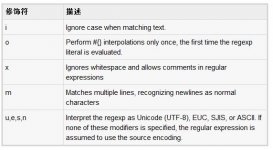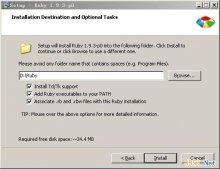简单邮件传输协议(SMTP)发送电子邮件及路由的e-mail邮件服务器之间的协议处理。
Ruby 提供 Net::SMTP 类的简单邮件传输协议(SMTP)客户端的连接,并提供了两个新的方法:new 和 start.
new 带两个参数:
- server name 默认为 localhost
- port number 默认为熟知的 25
start 方法带有以下这些参数:
- server - IP SMTP服务器名称,默认为localhost
- port - 端口号,默认为25
- domain - 邮件发件人的域名,默认为 ENV["HOSTNAME"]
- account - 用户名,默认为 nil
- password - 用户密码,默认为 nil
- authtype - 授权类型,默认为 cram_md5
SMTP对象有一个实例方法调用sendmail,后者通常会被用来做邮寄消息的工作。它有三个参数:
- source - 字符串或数组或任何同每个迭代一次返回一个字符串。
- sender - 一个字符串,它将会出现在电子邮件字段中。
- recipients - 代表收件人的地址的字符串的字符串或数组
例子:
下面是一个简单使用Ruby脚本的方法来发送一个电子邮件。试一次看看吧:
|
1
2
3
4
5
6
7
8
9
10
11
12
13
14
|
require 'net/smtp'message = <<MESSAGE_ENDFrom: Private Person <me@fromdomain.com>To: A Test User <test@todomain.com>Subject: SMTP e-mail testThis is a test e-mail message.MESSAGE_ENDNet::SMTP.start('localhost') do |smtp| smtp.send_message message, 'me@fromdomain.com', 'test@todomain.com'end |
在这里已经放置了一个基本的电子邮件消息,使用文件,在这里同时注意正确格式化标题。一封邮件需要发件人,收件人,主题头,从电子邮件的主体有一个空白行分隔。
随着消息要发送邮件使用Net::SMTP连接到本地机器上的SMTP服务器,然后使用 send_message 方法,从地址,目的地址作为参数(即使地址电子邮件本身范围内,这些并非总是用来将邮件路由)。
如果还没有在机器上运行一个SMTP服务器,可以使用的Net::SMTP远程SMTP服务器进行通信。除非使用一个webmail服务(如Hotmail或雅虎邮件),电子邮件提供商将提供外发邮件服务器的细节,可以提Net::SMTP,具体如下:
|
1
|
Net::SMTP.start('mail.your-domain.com') |
这行代码连接到SMTP服务器mail.your-domain.com 端口25。,而无需使用任何用户名或密码。不过,如果需要的话可以指定端口号或其他参数等。例如:
|
1
2
3
4
|
Net::SMTP.start('mail.your-domain.com', 25, 'localhost', 'username', 'password' :plain) |
这个例子连接mail.your-domain.com到SMTP服务器使用的用户名和密码以纯文本格式。它标识为localhost客户端的主机名。
使用Ruby发送HTML电子邮件:
当想要发送文本消息,Ruby所有内容将被视为简单的文本。即使会在短信中包含HTML标记,它会显示简单的文本和HTML标记将不会格式化HTML语法。但是Ruby的 Net::SMTP 提供了实际的HTML邮件发送HTML消息的选项。
在发送电子邮件消息时,可以指定一个MIME版本,内容类型和字符集发送HTML电子邮件。
例如:
下面的例子作为电子邮件发送HTML内容。试一次看看吧:
|
1
2
3
4
5
6
7
8
9
10
11
12
13
14
15
16
17
18
19
|
require 'net/smtp'message = <<MESSAGE_ENDFrom: Private Person <me@fromdomain.com>To: A Test User <test@todomain.com>MIME-Version: 1.0Content-type: text/htmlSubject: SMTP e-mail testThis is an e-mail message to be sent in HTML format<b>This is HTML message.</b><h1>This is headline.</h1>MESSAGE_ENDNet::SMTP.start('localhost') do |smtp| smtp.send_message message, 'me@fromdomain.com', 'test@todomain.com'end |
作为电子邮件的附件发送:
混合内容发送一封电子邮件,要求设置Content-type头为 multipart/mixed。然后,文本和附件部分可以指定 boundaries 范围内。
两个连字符后跟一个唯一的编号,不能出现在电子邮件的消息部分的边界开始。最后一个边界表示电子邮件的最后一节的结尾也必须有两个连字符。
附加文件使用 pack("m") 函数来base64编码传输之前进行编码。
例子:
下面的例子将文件 /tmp/test.txt 作为附件发送。试一次看看吧:
|
1
2
3
4
5
6
7
8
9
10
11
12
13
14
15
16
17
18
19
20
21
22
23
24
25
26
27
28
29
30
31
32
33
34
35
36
37
38
39
40
41
42
43
44
45
46
47
48
49
50
51
52
53
|
require 'net/smtp'filename = "/tmp/test.txt"# Read a file and encode it into base64 formatfilecontent = File.read(filename)encodedcontent = [filecontent].pack("m") # base64marker = "AUNIQUEMARKER"body =<<EOFThis is a test email to send an attachement.EOF# Define the main headers.part1 =<<EOFFrom: Private Person <me@fromdomain.net>To: A Test User <test@todmain.com>Subject: Sending AttachementMIME-Version: 1.0Content-Type: multipart/mixed; boundary=#{marker}--#{marker}EOF# Define the message actionpart2 =<<EOFContent-Type: text/plainContent-Transfer-Encoding:8bit#{body}--#{marker}EOF# Define the attachment sectionpart3 =<<EOFContent-Type: multipart/mixed; name=\"#{filename}\"Content-Transfer-Encoding:base64Content-Disposition: attachment; filename="#{filename}"#{encodedcontent}--#{marker}--EOFmailtext = part1 + part2 + part3# Let's put our code in safe areabegin Net::SMTP.start('localhost') do |smtp| smtp.sendmail(mailtext, 'me@fromdomain.net', ['test@todmain.com']) endrescue Exception => e print "Exception occured: " + e end |
注意:可以指定多个目的地内部数组,但他们需要用逗号分隔。




